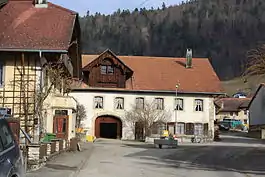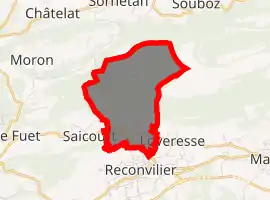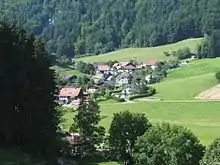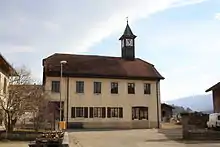Saules, Switzerland
Saules is a municipality in the Jura bernois administrative district in the canton of Bern in Switzerland. It is located in the French-speaking Bernese Jura (Jura Bernois).
Saules | |
|---|---|
 Saules village | |
 Coat of arms | |
Location of Saules 
| |
 Saules  Saules | |
| Coordinates: 47°15′N 07°13′E | |
| Country | Switzerland |
| Canton | Bern |
| District | Jura bernois |
| Government | |
| • Mayor | Maire |
| Area | |
| • Total | 4.25 km2 (1.64 sq mi) |
| Elevation | 743 m (2,438 ft) |
| Population (2018-12-31)[2] | |
| • Total | 151 |
| • Density | 36/km2 (92/sq mi) |
| Time zone | UTC+01:00 (Central European Time) |
| • Summer (DST) | UTC+02:00 (Central European Summer Time) |
| Postal code(s) | 2732 |
| SFOS number | 0707 |
| Surrounded by | Reconvilier, Saicourt, Sornetan, Souboz, Loveresse |
| Website | website missing SFSO statistics |
History
Saules is first mentioned in 1179 as Sales. The municipality was formerly known by its German name Saal, however, that name is no longer used.[3]
In 1246 the nobleman Albert of Saules was mentioned as a representative of Moutier-Grandval Abbey. In 1294 the nobleman Guidon of Saules was mentioned as owned a mill in the village. His mill remained in operation until 1912. The family name continues to appear in records from the 13th and 14th centuries. For most of the village's history it was under the authority of the provost of Moutier-Grandval and was a part of the lands of the Prince-Bishop of Basel. After the 1798 French invasion, Saules became part of the French Département of Mont-Terrible. Three years later, in 1800 it became part of the Département of Haut-Rhin. After Napoleon's defeat and the Congress of Vienna, Saules was assigned to the Canton of Bern in 1815.[3]
The village has remained mostly agrarian. Today about two-thirds of the jobs in Saules are still in agriculture, with a furniture shop and a sawmill providing some industrial jobs.[3]
Geography

Saules has an area of 4.28 km2 (1.65 sq mi).[4] As of 2012, a total of 1.84 km2 (0.71 sq mi) or 43.0% is used for agricultural purposes, while 2.25 km2 (0.87 sq mi) or 52.6% is forested. Of the rest of the land, 0.16 km2 (0.062 sq mi) or 3.7% is settled (buildings or roads) and 0.01 km2 (2.5 acres) or 0.2% is unproductive land.[5]
During the same year, housing and buildings made up 2.6% and transportation infrastructure made up 1.2%. Out of the forested land, 46.7% of the total land area is heavily forested and 5.8% is covered with orchards or small clusters of trees. Of the agricultural land, 2.6% is used for growing crops and 31.5% is pastures and 8.9% is used for alpine pastures.[5]
The municipality is located in the Trame valley near Reconvilier.
On 31 December 2009 District de Moutier, the municipality's former district, was dissolved. On the following day, 1 January 2010, it joined the newly created Arrondissement administratif Jura bernois.[6]
Coat of arms
The blazon of the municipal coat of arms is Argent three Ears Gules in saltire and palewise.[7]
Demographics
Saules has a population (as of December 2019) of 152.[8] As of 2010, 0.7% of the population are resident foreign nationals. Over the last 10 years (2001-2011) the population has changed at a rate of 2%. Migration accounted for 0.7%, while births and deaths accounted for 1.3%.[9]
Most of the population (as of 2000) speaks French (150 or 91.5%) as their first language, German is the second most common (13 or 7.9%) and Albanian is the third (1 or 0.6%).[10]
As of 2008, the population was 48.7% male and 51.3% female. The population was made up of 73 Swiss men (48.7% of the population). There were 76 Swiss women (50.7%) and 1 (0.7%) non-Swiss women.[11] Of the population in the municipality, 75 or about 45.7% were born in Saules and lived there in 2000. There were 61 or 37.2% who were born in the same canton, while 17 or 10.4% were born somewhere else in Switzerland, and 9 or 5.5% were born outside of Switzerland.[10]
As of 2011, children and teenagers (0–19 years old) make up 26.1% of the population, while adults (20–64 years old) make up 54.2% and seniors (over 64 years old) make up 19.6%.[9]
As of 2000, there were 64 people who were single and never married in the municipality. There were 83 married individuals, 10 widows or widowers and 7 individuals who are divorced.[10]
As of 2010, there were 19 households that consist of only one person and 7 households with five or more people.[12] In 2000, a total of 64 apartments (71.9% of the total) were permanently occupied, while 21 apartments (23.6%) were seasonally occupied and 4 apartments (4.5%) were empty.[13] The vacancy rate for the municipality, in 2012, was 2.17%. In 2011, single family homes made up 68.5% of the total housing in the municipality.[14]
The historical population is given in the following chart:[3][15]

Politics
In the 2011 federal election the most popular party was the Swiss People's Party (SVP) which received 59.1% of the vote. The next three most popular parties were the Social Democratic Party (SP) (9%), the Green Party (6.3%) and the Evangelical People's Party (EVP) (6.2%). In the federal election, a total of 73 votes were cast, and the voter turnout was 59.8%.[16]
Economy
As of 2011, Saules had an unemployment rate of 1.23%. As of 2008, there were a total of 32 people employed in the municipality. Of these, there were 20 people employed in the primary economic sector and about 7 businesses involved in this sector. 7 people were employed in the secondary sector and there were 3 businesses in this sector. 5 people were employed in the tertiary sector, with 2 businesses in this sector.[9] There were 91 residents of the municipality who were employed in some capacity, of which females made up 35.2% of the workforce.
In 2008 there were a total of 21 full-time equivalent jobs. The number of jobs in the primary sector was 11, all of which were in agriculture. The number of jobs in the secondary sector was 6 of which 5 were in manufacturing and 1 was in construction. The number of jobs in the tertiary sector was 4, with 3 in wholesale or retail sales or the repair of motor vehicles and 1 in the movement and storage of goods.[17]
In 2000, there were 4 workers who commuted into the municipality and 63 workers who commuted away. The municipality is a net exporter of workers, with about 15.8 workers leaving the municipality for every one entering. A total of 28 workers (87.5% of the 32 total workers in the municipality) both lived and worked in Saules.[18]
Of the working population, 9.9% used public transportation to get to work, and 58.2% used a private car.[9]
In 2011 the average local and cantonal tax rate on a married resident, with two children, of Saules making 150,000 CHF was 13%, while an unmarried resident's rate was 19.1%.[19] For comparison, the rate for the entire canton in the same year, was 14.2% and 22.0%, while the nationwide rate was 12.3% and 21.1% respectively.[20] In 2009 there were a total of 59 tax payers in the municipality. Of that total, 21 made over 75,000 CHF per year. The average income of the over 75,000 CHF group in Saules was 91,757 CHF, while the average across all of Switzerland was 130,478 CHF.[21]
Religion
From the 2000 census, 102 or 62.2% belonged to the Swiss Reformed Church, while 10 or 6.1% were Roman Catholic. Of the rest of the population, there were 34 individuals (or about 20.73% of the population) who belonged to another Christian church. There was 1 individual who was Islamic. 7 (or about 4.27% of the population) belonged to no church, are agnostic or atheist, and 10 individuals (or about 6.10% of the population) did not answer the question.[10]
Education

In Saules about 46.1% of the population have completed non-mandatory upper secondary education, and 10.1% have completed additional higher education (either university or a Fachhochschule).[9] Of the 9 who had completed some form of tertiary schooling listed in the census, 88.9% were Swiss men.[10]
As of 2000, there were no students attending any school in the municipality, but 19 students attended schools outside the municipality.[18]
References
- "Arealstatistik Standard - Gemeinden nach 4 Hauptbereichen". Federal Statistical Office. Retrieved 13 January 2019.
- "Ständige Wohnbevölkerung nach Staatsangehörigkeitskategorie Geschlecht und Gemeinde; Provisorische Jahresergebnisse; 2018". Federal Statistical Office. 9 April 2019. Retrieved 11 April 2019.
- Saules in German, French and Italian in the online Historical Dictionary of Switzerland.
- Arealstatistik Standard - Gemeindedaten nach 4 Hauptbereichen
- Swiss Federal Statistical Office-Land Use Statistics 2009 data (in German) accessed 25 March 2010
- Nomenklaturen – Amtliches Gemeindeverzeichnis der Schweiz Archived 2015-11-13 at the Wayback Machine (in German) accessed 4 April 2011
- Flags of the World.com accessed 18-July-2013
- "Ständige und nichtständige Wohnbevölkerung nach institutionellen Gliederungen, Geburtsort und Staatsangehörigkeit". bfs.admin.ch (in German). Swiss Federal Statistical Office - STAT-TAB. 31 December 2019. Retrieved 6 October 2020.
- Swiss Federal Statistical Office accessed 18 July 2013
- STAT-TAB Datenwürfel für Thema 40.3 - 2000 Archived 2013-08-09 at the Wayback Machine (in German) accessed 2 February 2011
- Statistical office of the Canton of Bern (in German) accessed 4 January 2012
- Swiss Federal Statistical Office - Haushaltsgrösse Archived 2014-10-06 at the Wayback Machine (in German) accessed 8 May 2013
- Swiss Federal Statistical Office STAT-TAB - Datenwürfel für Thema 09.2 - Gebäude und Wohnungen Archived 2014-09-07 at the Wayback Machine (in German) accessed 28 January 2011
- Statistischer Atlas der Schweiz - Anteil Einfamilienhäuser am gesamten Gebäudebestand, 2011 accessed 17 June 2013
- Swiss Federal Statistical Office STAT-TAB Bevölkerungsentwicklung nach Region, 1850-2000 Archived 2014-09-30 at the Wayback Machine (in German) accessed 29 January 2011
- Swiss Federal Statistical Office 2011 Election Archived 2013-11-14 at the Wayback Machine (in German) accessed 8 May 2012
- Swiss Federal Statistical Office STAT-TAB Betriebszählung: Arbeitsstätten nach Gemeinde und NOGA 2008 (Abschnitte), Sektoren 1-3 Archived 2014-12-25 at the Wayback Machine (in German) accessed 28 January 2011
- Swiss Federal Statistical Office - Statweb Archived 2012-08-04 at Archive.today (in German) accessed 24 June 2010
- Statistischer Atlas der Schweiz - Steuerbelastung, 2011 Politische Gemeinden (in German) accessed 15 May 2013
- Swiss Federal Tax Administration - Grafische Darstellung der Steuerbelastung 2011 in den Kantonen (in German and French) accessed 17 June 2013
- Federal Tax Administration Report Direkte Bundessteuer - Natürliche Personen - Gemeinden - Steuerjahr 2009 Archived 2014-10-06 at the Wayback Machine (in German and French) accessed 15 May 2013
| Wikimedia Commons has media related to Saules. |